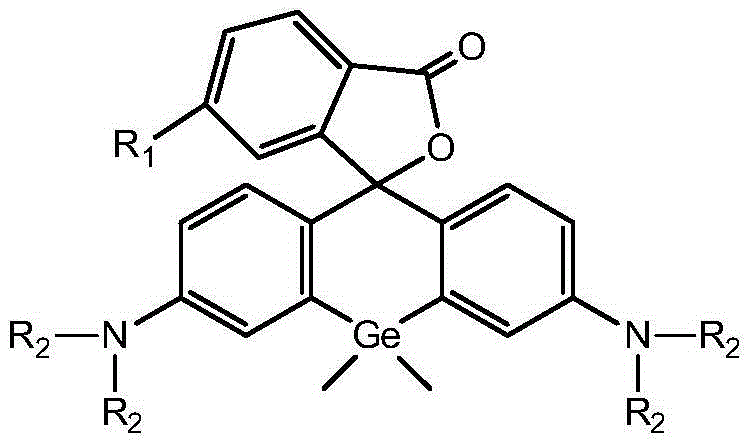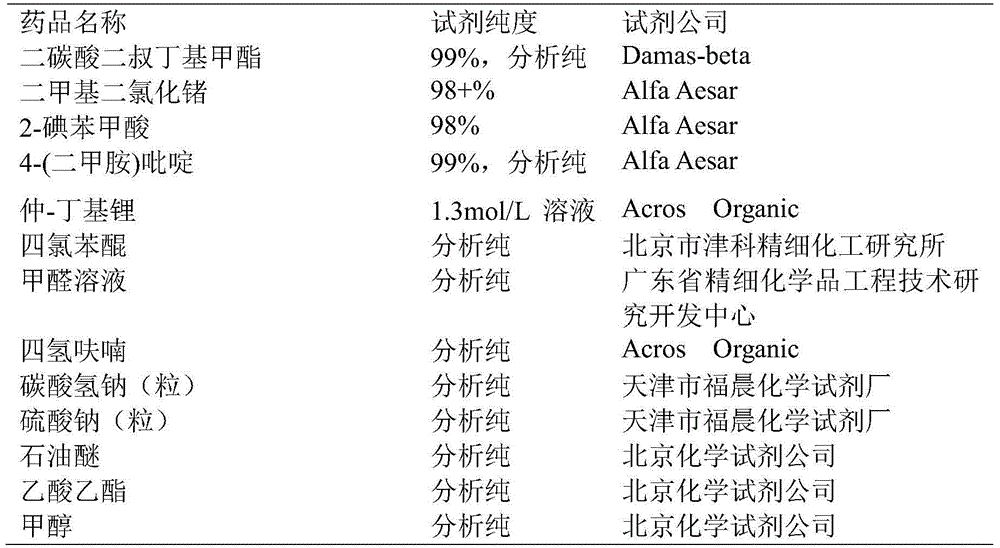Polarity-sensitive fluorescence probe and preparation method and application thereof
A fluorescent probe and sensitive technology, applied in the field of fluorescent sensors, can solve the problems of being unsuitable for biological detection and short emission wavelength, and achieve the effects of convenient detection operation, simple preparation method and fast response
- Summary
- Abstract
- Description
- Claims
- Application Information
AI Technical Summary
Problems solved by technology
Method used
Image
Examples
Embodiment 1
[0035] The polarity sensitive fluorescent probe of the present invention, structural formula is:
[0036]
[0037] Among them, R 1 = H, R 2 =CH 3 ,
[0038] The reaction equation is as follows:
[0039]
[0040] The preparation method is as follows:
[0041] (1) Dissolve 5.00g (25mmol) of compound a-1 in 5ml of formaldehyde solution with a volume concentration of 37% and 40ml of acetic acid mixed solution, stir at 60°C for 30 minutes, after natural cooling, distill off the acetic acid under reduced pressure at 100°C, Then add saturated NaHCO 3 solution. The resulting solution was extracted with 3 times the volume of ethyl acetate to extract the organic phase, and the organic phase was washed three times with deionized water and three times with brine successively, and then washed with Na 2 SO 4 Dry, remove the solvent by distillation under reduced pressure at 60°C to obtain a solid, which is separated by silica gel column chromatography (the eluent is a mixed sol...
Embodiment 2
[0046] The polarity sensitive fluorescent probe of the present invention, structural formula is:
[0047]
[0048] Among them, R 1 =CH 3 CH 2 , R 2 =CH 3 CH 2 .
[0049] The reaction equation is as follows:
[0050]
[0051] The preparation method is as follows:
[0052] (1) 5.66g (25mmol) of compound a-2 was dissolved in 5ml of a volume concentration of 37% formaldehyde solution and 40ml of acetic acid mixed solution, stirred at 60°C for 30 minutes, after natural cooling, acetic acid was distilled off under reduced pressure at 100°C, Then add saturated NaHCO 3 solution. The resulting solution was extracted with 3 times the volume of ethyl acetate to extract the organic phase, and the organic phase was washed three times with deionized water and three times with brine successively, and then washed with Na 2 SO 4 Dry, remove the solvent by distilling under reduced pressure at 60°C, and separate by silica gel column chromatography (the eluent is a mixed solution...
Embodiment 3
[0057] (1) Preparation of probe solution:
[0058] Two parts of compound f-1 (2.3mg) prepared in Example 1 were fixed in a 25ml volumetric flask with 1,4-dioxane and methanol as solvent to obtain 2×10 -4 mol / L f-1 solution, take 2.5ml of two solutions respectively, dilute and constant volume in a 100ml volumetric flask to obtain 5μmol / L f-1 solution (solvent is 1,4-dioxane), weigh It is solution I, and 5 μmol / L f-1 solution (solvent is methanol), called solution II.
PUM
 Login to View More
Login to View More Abstract
Description
Claims
Application Information
 Login to View More
Login to View More - R&D
- Intellectual Property
- Life Sciences
- Materials
- Tech Scout
- Unparalleled Data Quality
- Higher Quality Content
- 60% Fewer Hallucinations
Browse by: Latest US Patents, China's latest patents, Technical Efficacy Thesaurus, Application Domain, Technology Topic, Popular Technical Reports.
© 2025 PatSnap. All rights reserved.Legal|Privacy policy|Modern Slavery Act Transparency Statement|Sitemap|About US| Contact US: help@patsnap.com



